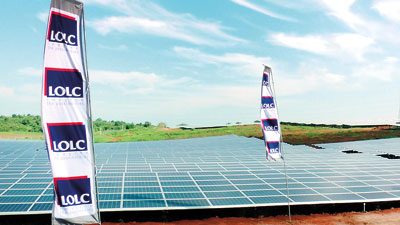More rooftop solar power and solar plants urged to tackle impending SL power crisis
View(s):
File picture of an LOLC solar power plant at Hambantota
The Public Utilities Commission of Sri Lanka (PUCSL), after assessing the country immediate and long terms power needs is, among other measures, recommending immediate installation of rooftop and scattered solar plant and immediate technical and managerial solutions to increase the reliability of the Norachcholai Lakvijaya coal power plant.
The recommendations, released to the media recently, came in a report “Electricity Supply 2020 and Beyond: Challenges and Recommendations” where it was also observed that:
“Comparison of past Least Cost Long Term Generation Expansion Plans (LCLTGEP) with actuals suggests that there are significant shortcomings in the implementation of LCLTGEPs. This has resulted cost overruns, load shedding, and unplanned power procurement in past few years and these consequences are expected to be continued in next few years.”
The report has proposed short and medium term measures to ensure the continuity of electricity supply until 2020 and long term steps as permanent solutions to ensure long term energy security in a sustainable manner.
Short Term (For the next six monthd)
The energy supply is expected to be sufficient in short term under most probable hydro condition and no additional measures will be required. However in an event of an extraordinary low rainfall scenario, if the hydro reservoir levels fall below a certain level the following actions are recommended:
a) For September- October period – Electricity demand can be fully catered if 60 MW of additional generation capacity is available from September onwards and 110 MW of additional generation capacity is available from October onwards. The following options are available for the required capacity additions:
i) Procurement of electricity from 60 MW emergency power plants (PPA – Power Purchase Agreement expired in mid-August).
ii). Operating the Kelanithissa power plant (which is unavailable due to steam turbine failure), on open cycle mode (110 MW).
iii) Acquiring more capacity under the self-generation scheme.
iv) Disconnect bulk customers, who own on-site generators from the system, to minimize inconvenience to consumers in case of sudden load shedding requirement.
b) For November- February period-
i) Immediately start the tender process for procurement of 150 MW thermal generation capacity for 10 months from November 2017. However, the decision of entering into a PPA should be subject to the hydro reservoir level as at the end of October. Committing to a PPA can be recommended if the reservoir levels are below 630 GWh and are at a decreasing trend.
ii) Call tenders to obtain the 150 MW capacity as several generation plants (eg. 3×50 MW generation plants), keeping the flexibility to procure lower generation capacity depending on the hydro condition. The size and location of the plants shall be decided by the transmission licensee subject to transmission constraints in the national grid.
iii) Options such as open-cycle operation of Kelanithissa Power Plants or extension of expired PPA for 60MW emergency power plants (expired in August 2017) should be given due consideration by transmission licensee in making a decision on power procurement, to ensure the least cost criteria.
iv) However if the transmission licensee decides to procure capacity lower than 150 MW in November 2017, it is recommended to take initiatives to procure the said total 150 MW thermal generation capacity from February 2018 to August 2018. The actual capacity addition should be done considering the actual hydro condition at the time of entering in to the PPA (if reservoir level is below 615 GWh and not showing an increasing trend by February 2018, it is considered a low reservoir level).
c) Special attention should be given to ensure continuous fuel supply to all thermal power plants under both hydro scenarios.
d) In addition to what had been discussed above, both rooftop and scattered solar plant additions should be expedited.
Medium Term (2018-2020)
a) The proposed plant additions (both thermal and renewables) in LCLTGEP 2018-37 should be conducted according to the CEB implementation plans presented at the Sub-Committee on Power and Renewable Energy meeting held on August 10, 2017.
b) Transmission system should be timely expanded according to the new plant additions expected.
c) Groundwork on development of natural gas infrastructure should be started immediately to ensure fuel availability for all existing and future gas turbines and combined cycle plants.
d) Continuous fuel supply to all thermal plants should be ensured throughout the period.
e) Even with recommended capacity additions, timely measures should be taken to avoid energy deficits that are likely to occur in the first half of 2018 and also in March and August (2019) and March 2020, under dry conditions.
f) Demand side management measures (energy efficiency, conservation, peak demand shifting, etc) should be expedited.
g) Immediate technical/ managerial solutions should be taken to increase the reliability of the Norachcholai Lakvijaya coal power plant.
Long Term (permanent solutions)
a) Liberalize the generation sector to encourage investments by amending Section 8 and 9 of Sri Lanka Electricity Act, while creating a robust power procurement programme that can introduce price competition to electricity sector.
b) India interconnection project should be expedited.
c) Sri Lanka Electricity Act should be amended to allow ‘wheeling’ which is described “as transporting electric energy (megawatt-hours) from within an electrical grid to an electrical load outside the grid”.
d) Streamline the generation planning process and revise the format of LCLTGEP in line with exact provisions of the “Grid Planning Code”.
e) Fully ring-fencing transmission licensee should be followed by administrative separation to ensure that transmission licensee operates independently from CEB in the broader national interest, to realise the objective of having a reliable, secure and cost competitive electricity industry.


